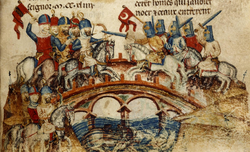نبرد موهی
از ویکیپدیا، دانشنامه آزاد
نبرد موهی (انگلیسی: Battle of Mohi) نبرد اصلی بین امپراتوری مغول و پادشاهی مجارستان در طول تهاجم مغولها به اروپا بود. این نبرد در موهی، در جنوب غربی رودخانه ساجو رخ داد. این نبرد منجر به پیروزی مغولها شد که ارتش سلطنتی مجارستان را نابود کردند.
| نبرد موهی | |||||||
|---|---|---|---|---|---|---|---|
| بخشی از First Mongol invasion of Hungary | |||||||
 | |||||||
| |||||||
| طرفهای درگیر | |||||||
|
پادشاهی مجارستان جنگطلب جزئی: دوکنشین اتریش | امپراتوری مغول | ||||||
| فرماندهان و رهبران | |||||||
|
بلای چهارم Coloman of Slavonia (کبج) Ugrin Csák † Matthias Rátót † Frederick II of Austria Denis Tomaj † Rembald de Voczon |
باتوخان سبتای Shiban برکه خان Boroldai Bakatu † | ||||||
| واحدهای درگیر | |||||||
|
پیادهنظام شوالیههای معبد کمان زنبورکیmen سوارهنظام سبک |
سوار کماندار نیزهدار[۲] منگونل Possibly Chinese firearm units and other gunpowder units | ||||||
| قوا | |||||||
|
80,000[۳] 50,000[۴] 25,000[۵][۶][۷] |
~15,000–30,000 cavalry (contemporary sources)[۸] | ||||||
| تلفات و خسارات | |||||||
|
~10,000 (contemporary sources)[۱۱] Most of the army[۱۲] |
Few hundreds[۱۳] Very heavy[۱][۱۴][۱۵][۱۶] | ||||||
منابع
پیوند به بیرون
Wikiwand - on
Seamless Wikipedia browsing. On steroids.

